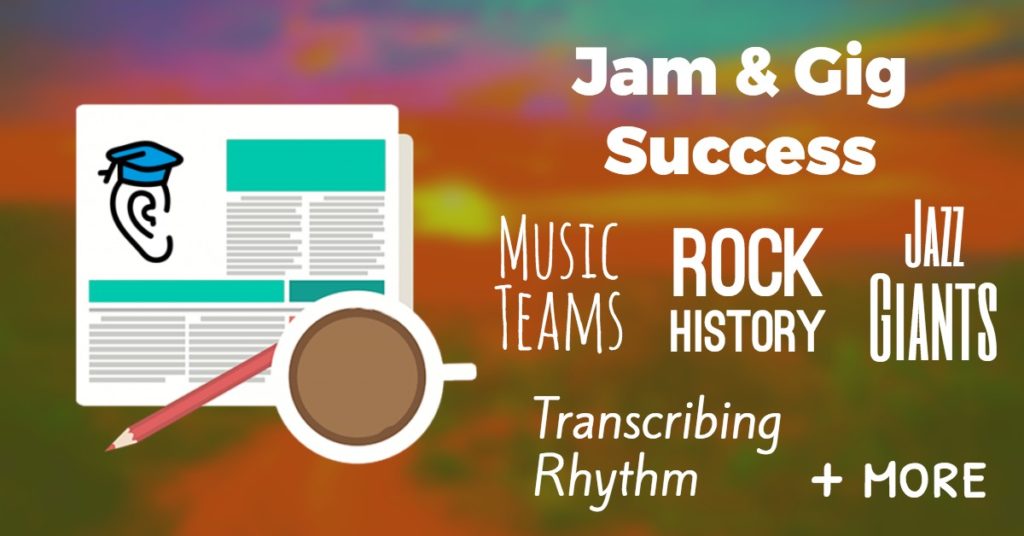As musicians, we grow the most when we learn from one another and work as a team. Whether we listen to and learn from those who have acquired knowledge, or just admire something cool our colleagues did, we prosper most when we learn together.
We can also learn from athletes, our own mentors, or simply by heeding the advice from people who have “been there and done that” and are willing to share what they know. Being part of a team can mean group appreciation of the contributions of others to music, as well. Music is a team sport.
This week we pay homage to the greats of Jazz and Rock and Roll, and take advice on gigging, music transcription and team-work from the experts.
But first… have a look at this video to inspire your weekend!
The Secrets of a Successful Jam
 One of the greatest gifts a musician can give themselves is the gift of attending a live jam. But for some people that seems a bit intimidating. Never fear! “Jamiquette” expert Kim Alexander is here to share her expert advice on having a successful jam session!
One of the greatest gifts a musician can give themselves is the gift of attending a live jam. But for some people that seems a bit intimidating. Never fear! “Jamiquette” expert Kim Alexander is here to share her expert advice on having a successful jam session!
She is well-positioned to give advice on the topic, having been running a jam session called Music Night for over a decade. Folk musician and activist Pete Seeger described her jamiquette tips as “wonderful”, encouraging her to print them up in pamphlet form, which she duly did, now distributing them at events such as the Strawberry Music Festival where she teaches a “Learn to Jam!” workshop. Kim kindly made her “Jamiquette” poster and “Learn to Jam!” pamphlet available to our readers, so go ahead and download your copies!
Do you want to see what a real live jam session looks like? Take a look at Mike Lockheed’s video to see how he employs “jamiquette” at this jam session:
All music disciplines require doing – and jazz is no exception. So, do you want to know how to kill it at that upcoming jazz jam? Read this blogpost from Learn Jazz Faster and here’s more jazz jam session advice from Jazz Guitar Online.
What’s New in MU…
Things have been very busy at Musical U lately and after last week’s quick peek inside we wanted to be sure to give you a quick overview of all the new and fun things which have arrived at MU for August!
First of all, we’ve added a really exciting new module to the site called Finding the Key which teaches you a four-step process you can use to easily find the key of a piece of music by ear. The second major addition this month was a total overhaul of the member profile system. Now you can share a lot more information about yourself (if you choose to do so) and see a lot more information about other people, so that you can get to know other members inside Musical U more easily. Learn more about the latest Musical U happenings right here or watch below:
An Intro to Rock
 The long, complex and storied history of Rock and Roll goes back 70 years to the rhythm and blues traditions of the early 20th century. Musical U has a brief look at the history of Rock and Roll, its qualities and social influences.
The long, complex and storied history of Rock and Roll goes back 70 years to the rhythm and blues traditions of the early 20th century. Musical U has a brief look at the history of Rock and Roll, its qualities and social influences.
For a thorough and amazingly well-executed timeline of Rock and Roll, see this graphic from Silicon Valley Data Science and for a 15 minute mash-up of the history of rock and roll, enjoy this montage from Ithaca Audio:
Wait a minute. Did you find that there something missing in that video? As we’ve seen, the history of rock music tends to focus on the white male artists from the 1950’s onwards. What about contributions to rock and roll by female artists and African Americans? No contribution was greater than the “Godmother” of Rock and Roll, Sister Rosetta Tharpe. The Odyssey Online has a lovely biography on this great pioneer of rock.
Transcribing the Rhythm Section
 In the fourth part of our series on transcribing music, we take a look at the meat-and-potatoes of a music transcription: transcribing the rhythm section, which usually includes the rhythm guitar, the piano, bass player, and the drums.
In the fourth part of our series on transcribing music, we take a look at the meat-and-potatoes of a music transcription: transcribing the rhythm section, which usually includes the rhythm guitar, the piano, bass player, and the drums.
As mentioned in that article, it’s very important to have a basic understanding of rhythm to be able to transcribe it. Start with this video tutorial on transcribing rhythmic patterns from Michael Avery and then check out these great rhythm notation resources from Olchs Music, including PDF file downloads and transcribing exercises.
Central to most rhythm sections is the bass player’s part, so why not try these six simple short bass lines for transcribing practice from Smart Hobby Musician Blog?
Six Giants of Jazz Improvisation
 As Igor Stravinsky, a great composer of the 20th century, once said, “Lesser artists borrow, great artists steal.” The complex and wildly-varied genre of jazz music has been influenced by a great many musicians who built on one another. So why not stand on the shoulders of jazz giants and learn from them? In Six Giants of Jazz Improvisation we discuss six of jazz’s great improvisors, from Charlie Parker to Pat Metheny.
As Igor Stravinsky, a great composer of the 20th century, once said, “Lesser artists borrow, great artists steal.” The complex and wildly-varied genre of jazz music has been influenced by a great many musicians who built on one another. So why not stand on the shoulders of jazz giants and learn from them? In Six Giants of Jazz Improvisation we discuss six of jazz’s great improvisors, from Charlie Parker to Pat Metheny.
For another take on some of the greatest jazz musicians of all time, check out this list by Enki Village. The history of jazz may be heavy with the contributions by male artists, but what about the contributions of female jazz artists? Have a look at Sabotage Times’ article featuring ten of jazz’s greatest ladies.
Putting on a Successful Show
 In Musical U’s “Performing Live” series so far they’ve covered the art of rehearsing, planning a show, booking gigs and promoting yourself. Now it’s time for the best part – the show! In Performing Live: The Show they’ll take you through the before, during and after stages of performing live on stage.
In Musical U’s “Performing Live” series so far they’ve covered the art of rehearsing, planning a show, booking gigs and promoting yourself. Now it’s time for the best part – the show! In Performing Live: The Show they’ll take you through the before, during and after stages of performing live on stage.
Now that you are fully prepared to take the plunge and go before a live audience, consider this advice from Help for Bands on the do’s and dont’s for live performances and these eight tips from New Artist Model on how to make a good impression at gigs.
We all like to make money, right? I mean, we can USE money! Here’s some great advice from Ari Herstand on how to maximise the tips you get at your next gig.
Sports and Music
 With the Olympics on our minds, do you ever wondered how those athletes handle so much pressure to perform? How do they do it? There are a lot of parallels between training for a sport and training for music. Some of these are obvious: you need determination, a clear goal in mind, and careful, regular practice. But what about the things you might not have thought of, like team-mates, a coach, and a place to train?
With the Olympics on our minds, do you ever wondered how those athletes handle so much pressure to perform? How do they do it? There are a lot of parallels between training for a sport and training for music. Some of these are obvious: you need determination, a clear goal in mind, and careful, regular practice. But what about the things you might not have thought of, like team-mates, a coach, and a place to train?
We here at Easy Ear Training believe in the importance of these three ideas and we discussed them in depth this week in 3 Sports Ideas That Can Help You in Music.
As we mentioned, one of the most important things you can for yourself as a musician is to build a supporting team. DIY Musician has this very important advice on the 16 team members you might need.
It’s not just team-work. The psychology of athletes and performers is often very similar and Making Music Magazine explains how musicians can benefit from sports psychology. Here’s Abra Garfield, an endorsed Sport and Performance Psychologist, discussing his approach to working with athletes, performers and musicians to develop the mindset necessary to set and achieve goals.
That’s it for this week. But before we go, I wanted to make sure you didn’t miss this astonishing cover song from the Easy Ear Training Facebook page this week:
Being part of a team has benefits – whether it’s in showing respect to those who created a musical tradition and those who continued it, or in learning from team-mates and teachers who know their craft and love to share it. We can all learn so much from one another in music – if we just listen.






